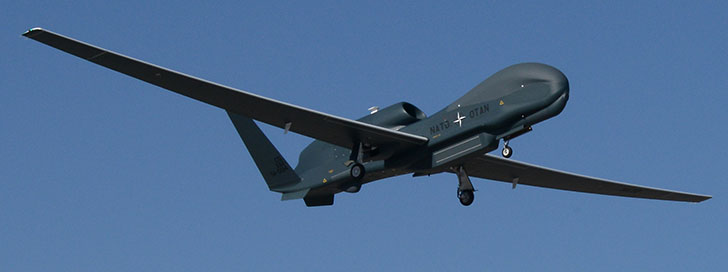
NATO's first Alliance Ground Surveillance (AGS) aircraft, built by Northrop Grumman, successfully completed its first flight on Dec. 19, 2015. (Photo by Alyssa Cooper)
A derivative of the wide-area surveillance Global Hawk, the unmanned aircraft has the ability to fly for up to 30 hours at a time. The high-altitude long-endurance system will perform all-weather, persistent wide-area terrestrial and maritime surveillance in near real-time. The NATO-owned and operated system will provide intelligence, surveillance and reconnaissance capabilities to support a range of NATO missions such as protection of ground troops and civilian populations, border control, maritime safety and humanitarian assistance.
The aircraft is equipped with leading-edge technology, including the Multi-Platform Radar Technology Insertion Program (MP-RTIP) sensor. The MP-RTIP sensor will provide critical data to commanders during operations, in any weather, day or night. Utilizing the MP-RTIP sensor, the NATO AGS system will be able to fuse sensor data, continuously detect and track moving objects and provide imagery of selected objects.
NATO AGS will be based in Sigonella, Italy. The Italian airbase is already home to U.S Air Force-owned Global Hawks. Northrop Grumman will begin ferrying the first NATO AGS aircraft to Italy in 2016. The system is being procured by 15 NATO nations (Bulgaria, Czech Republic, Denmark, Estonia, Germany, Italy, Latvia, Lithuania, Luxembourg, Norway, Poland, Romania, Slovakia, Slovenia and the United States), and includes five aircraft and European-sourced mobile and transportable ground stations. The ground stations will provide data link connectivity, data processing and exploitation capabilities to multiple deployed and non-deployed operational users. Following acquisition, NATO AGS will become a 28 Alliance nation fully-owned and operated NATO capability.